Hi, guys. Its me @puzzlevotex.
In this article, I wanted talk about how to make better basslines.
Your bassline plays a huge role in your mix. Especially in electronic and dance music.
It is the foundation of your track!
It provides the infrastructure which your melodies and chords are built on top of.
Your bassline is the ‘core of your song’ which provides the groove, and it makes a listeners body unconsciously move to the music.
A bassline can be added or pulled out of a track at key times, to get an audience really moving.
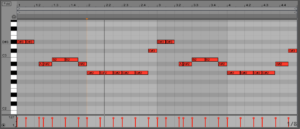
I spend ALOT of time working on the bassline for my tracks.
I also like to make and test ‘multiple bass melodies’ to find one that is simple, fits nicely with my drum track, and also has a nice groove.
Sometimes i’ll spend an hour just testing different basslines to find one that:
- is simple, but melodically interesting
- has melodic ideas that are repeatable and catchy
- provides a groove that makes your body want to move
- leads to the next chord in an interesting way
Other important aspects of a bassline include:
- its tone (the synth patch)
- how it is EQed in your mix
- how effects are applied to it in your mix.
Finding a Good Bass Tone or Timbre
An important part of your track, is the tone or timbre of your bass sound.
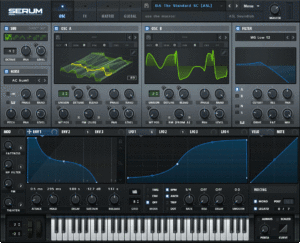 If you use a good hardware synth or VST synth plugin (like Serum), you’ll save alot of time searching for the right tone.
If you use a good hardware synth or VST synth plugin (like Serum), you’ll save alot of time searching for the right tone.
BUT, If your not working with a great synth sound, you can always improve the tone and color by adding EQ and effects.
I like to program my basslines with midi, then cycle through the bass presets in Serum until I find one that fits in the mix and has a unique, memorable sound.
EQing Your Bass
How you will EQ your bass track, depends on the other instruments in the mix.
Here are the most Common ways i will try applying EQ to my bass tracks:
- I try boosting the upper end of the bass sound around 200 – 400 hz to add color and make the upper end of the bass sound stand out in that range.
- Sometimes i test cutting off all of the high end frequencies of the bass using a low pass filter at around 80-200 HZ.
- If you aren’t getting enough of a booming bass sound, try boosting it at around 80 hz.
(There are no rules, whatever sounds good is what is right)
Making an Interesting Bass Melody
Your bassline provides a feeling of movement and a groove.
It leads the listener to the next chord, and tends to move in sync with the kick drum.
Here are 3 ways you can make your bass melody more interesting:
- try using larger intervals.
- try using repetitive motifs that are catchy and memorable.
- try to create a groove that makes your body want to move to the music.
A bassline that i love is “Hell of a Life” by Kanye West.
The reason i like the bassline in “Hell of a Life” it that has a catchy melodic idea that is repeated multiple times.
I like how it sounds when it goes down to the low f# note.
It also has a nice groove that stands on its own without needing much help, other than a drum beat.
I try to make a bassline that stands on its own with no accompaniment. (like the bassline in ‘Hell of a life”).
How to Draw in Moving Filters on your Bassline
One way to make your bass sound unique is to draw in some filter movement.
You can use peak, lowpass, or highpass filters to change the tone of your bass sound in a rhythmic pattern.
Filter movement will make your bass sound more interesting, without altering your groove and progression.
The Wobble Bass Sound
The ‘wobble bass’ sound, used by artists like Bassnectar (one of my favorite producers), is a cool effect that can be created with a filter, to cutoff or boost certain frequencies.
Here’s a video that shows how to use a sine wave LFO to control the movement of a filter on a bass in FL Studio:
How to create wobble bass with a peak filter
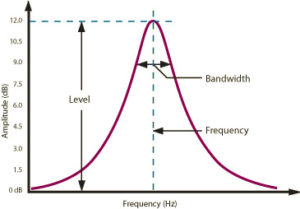 A ‘peak filter’ provides a boost of a narrow band of frequencies.
A ‘peak filter’ provides a boost of a narrow band of frequencies.
The frequency band of your peak filter can then be swept in a rhythmic pattern by using plugin automation to create the ‘wobble effect’.
You can also try sweeping low pass or highpass filters in the same way.
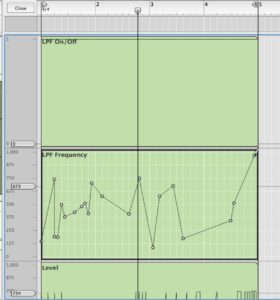
The image to the left shows what it would look like if you drew in some low pass filter movement with plugin automation.
Using Presets with Moving Filters on Your Bass
Synth VSTs like Serum have lots of cool presets which will give you that ‘wobble bass’ sound, without using automation.
The filter movement on these presets can be controlled with an LFO, an envelope, or a side-chain. You can then alter the sound my changing the parameters on the LFO, envelope, etc.
Using Tuned 808s as a Bassline
An 808 kick hits a listener hard in the same way that a rock guitar does.
A ‘tuned 808 kick’ is a kick that has a pitch.
Tuned 808s can be used in place of, or in combination with, a synth bassline to provide a groove and a progression.
You can make your own tuned 808s with a sinewave oscillator and an envelope. Or, you can find a pack of tuned 808 sounds to download. (try googling ‘free tuned 808 samples’)
Here’s a video showing how you can tune your 808s in Ableton:
Adding Effects to your Bassline
Effects can be applied to improve the timbre, color, wideness, and help your bass mix better in your track.
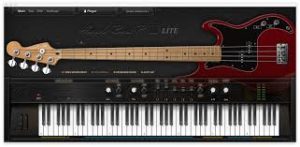 There are no rules in music. You can apply effects however you like.
There are no rules in music. You can apply effects however you like.
BUT, i will commonly try certain effects when i’m creating a bass sound.
Effects i like to test on a bassline include:
Distortion – I like using distortion on bass to add color to the sound as well as adding a bit of energy to the upper end of the sound in the 200 – 400 hz range. Distortion also sounds really good on tuned 808s.
Widening – I like to use a widener to create a large bass sound in the mix. Stereo effects like reverb, chorus, and distortion can also be used to widen a track.
Chorus – a bit of chorusing can sound good. I tweak the rate, to give it a bit of movement,
Flange – a little bit of flange sounds cool and provides movement.
Reverb – adding a bit of reverb sounds good, but i try not to overdo it.
I think i covered most aspects of creating a bassline. BUT, if i missed something or you have a tip you think i should include, tell me @puzzlevortex
*Also, i’m starting to do live streams djing drum n bass on twitter. I just got a pioneer DDJ-SX2, so i’m going to be practicing with it alot.